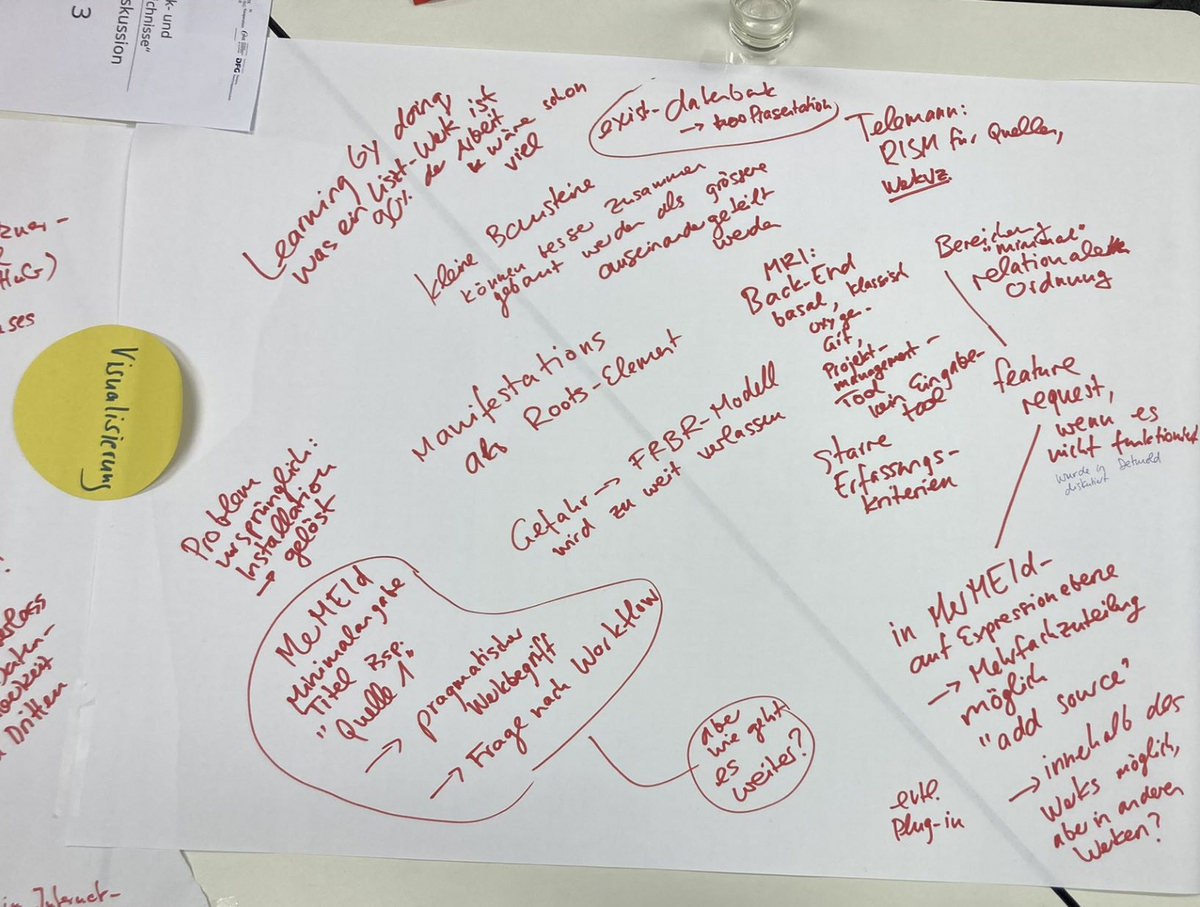Brief Report | 06. February 2023
Digital Source and Work Indexes in Musicology, Workshop at the SLUB, November 10-11, 2022

Workshop Work Indexes
"Digital Source and Work Indexes in Musicology Workshop at the SLUB, November 10-11, 2022." CC-BY-SA Creator: Katrin Bicher, Owner: Katrin Bicher
"The (...) new edition of the Beethoven catalogue of works will probably be the last to appear in print. The future of such a collection and preparation of information lies in the digital medium."
These are the closing words of the introduction to the two big volumes that became the new landmark of Beethoven research in 2014. Since then, several projects have laid the foundations for digital source and work catalogues using the XML schema MEI (Music Encoding Initiative). More projects are in the planning stage - some work catalogues are based on TYPO3 extensions, others use independent presentation systems for MEI data.
The possibilities of a digital catalogue will be particularly fruitful for complex works or collections of works with multiple references and connections - as is to be expected, for example, in the case of Franz Liszt. His works often developed fluidly over decades and often enough in processes of collective authorship, so that concepts such as "original" and "adaptation" or "work" and "version" are not always suitable. This is manifested in three existing attempts at systematization (Raabe, Searle, Mueller/Eckhardt)*, that show different (and not always satisfactory) results.
In June 2022, the "Digital Liszt Sources and Works Catalogue" (LisztQWV, carried out by the University of Heidelberg, the SLUB Dresden and the Goethe and Schiller Archive Weimar) was launched. This long-term project funded by the German Research Foundation (DFG) aims at enabling different approaches to Franz Liszt's musical oeuvre and the corresponding sources in the digital space. In order to exchange experiences and to discuss the conceptual and technical basis of the planned catalogue, the project team invited ongoing and completed projects and other representatives of the digital community in cooperation with NFDI4Culture to a workshop in Dresden on November 10 and 11.
Input presentations, a poster session, specialized group discussions as well as a concluding World Café enabled a multifaceted exchange. Staff members of the LisztQWV first presented the current status of the project, in particular the already ongoing indexing of sources as well as first considerations on data management and data flows. Peter Stadler (Paderborn) presented the MerMEId software developed in Copenhagen. This input mask for metadata in MEI format is currently being further developed as a community project in Paderborn. Laurent Pugin (RISM Digital Center, Bern) spoke about the role that the International Inventory of Musical Sources RISM plays currently and could play in the future in the field of digital work catalogues. Dennis Ried (Paderborn), as spokesman for the MEI-Metadata and Cataloging Interest group, addressed the work with the MEI header as well as opportunities and challenges in applying the FRBR levels to complex works or collections of works. The Functional Requirements for Bibliographic Records make a conceptual distinction between the levels Work, Expression, Manifestation and Item which can cause complications at various points.
The participating projects on Anton Bruckner, Christoph Willibald Gluck, Johannes Brahms, Joseph Haydn, Georg Philipp Telemann and Franz Liszt as well as on Near Eastern music manuscripts (Corpus Musicae Ottomanicae) presented their respective approaches in a poster session. It quickly became apparent that a one-size-fits-all solution does not exist. Another poster by Silke Reich addressed the representation of performances in the FRBR model.
In the discussions, several aspects proved to be relevant across the projects. Since the available oeuvres and the existing data differed greatly, these topics are approached in different ways. Particular emphasis was placed in the discussion on the relationship between local data storage on the one hand and third-party repositories, in particular RISM (that can be used for primary data indexing or for displaying data that has been indexed elsewhere) and authority data hubs on the other. Another key aspect in the discussion were the data flows which have to be planned precisely due to different data formats (including MARC21, MEI, or MerMEId-specific MEI) and have consequences for data sovereignty and versioning. Other important aspects included front-end presentation to keep user experience in mind, the design of input masks to standardize entries, and workflows. From an IT perspective, spotlights were cast on emergent technologies such as Semantic Data, which are gaining ground in the Digital Humanities. Now, based on the results of the workshop, we are beginning with the detailed planning of the technical realization of the LisztQWV. Moreover, the participants of the workshop unanimously agreed that the fruitful exchange between the projects should be continued!
Severin Kolb, Katrin Bicher und Matthias Richter
* Peter Raabe: Franz Liszt, Bd. 2: Liszts Schaffen, Stuttgart 1931 (Tutzing 1968).
* Humphrey Searle and Sharon Winklhofer: Franz Liszt, in: Chopin, Schumann, Liszt. The New Grove Early Romantic Masters, New York und London 1985, S. 237–378.
* Alan Walker, Maria Eckhardt and Rena Charnin Mueller: Art. „Liszt, Franz“, in: The new Grove dictionary of music and musicians, vol. 14, London und New York 2001, S. 755–877.